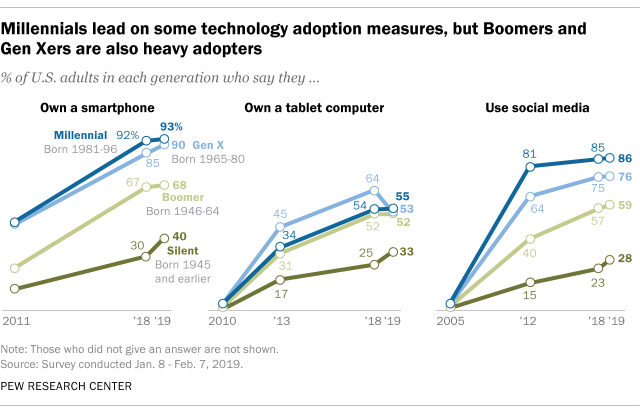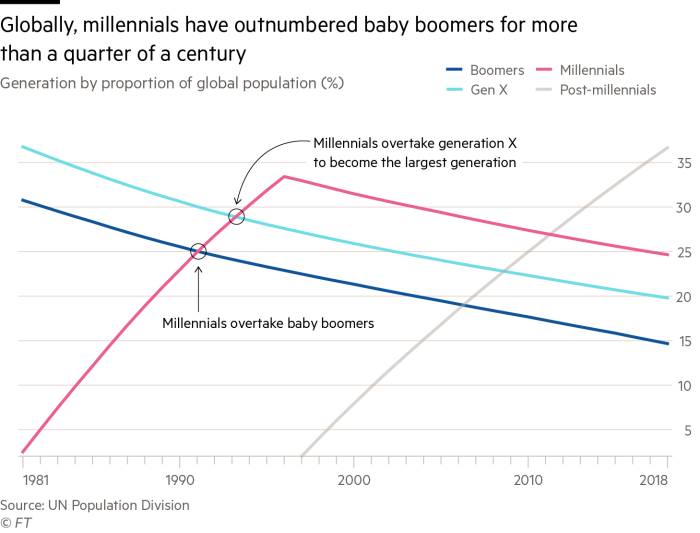With nearly $200M in yearly purchasing power, millennials (born between 1981 and 1996) are changing the way brands advertise their products & services in today’s rapidly-evolving, competitive landscape.
On a surface level, it’s convenient to simply generalize the millennial generation—they’re always on their phones, and spend an inordinate amount of time crafting an online persona, but they’re also the same people who are the most open-minded about social causes like climate change. So, why are marketers everywhere spending valuable marketing dollars to meticulously analyze their spending patterns and psychographics?
The answer’s simple: For brands looking to scale, understanding exactly what millennials want can be an absolute game-changer. Let’s quickly go over a few reasons why you should care about marketing to millennials.
Millennials make up 25% of the United States population:
According to the population projections from the U.S. Census Bureau, millennials will be surpassing Baby Boomers (born between 1944 and 1964) as the largest group of living adult generations. While they successfully outnumbered Generation X almost 26 years ago, they’re only now becoming the most populous (80 million) generation across the country.
While most millennials haven’t reached their peak purchasing power yet (due to student loans and starting a family), they are certainly heading that way, and brands realize the importance of getting in front of them early. There are also more millennials in the workforce than other generations, with an expected $1.4 trillion in disposable income by the year 2020.
….and they are smart.
Millennials are the best-educated group of young adults in U.S. history:
Today, approximately one-third of millennials have at least a four-year college degree, and 54 percent of them have already invested in a business of their own or are planning to do so in the immediate future.
Given that 25 percent of the millennials are parents and 42 percent have student debts upwards of $30,000, most of them haven’t reached their peak purchasing power yet. However, they’re slowly catching up—for example, 87 percent of the working millennials currently hold senior management positions in their respective workplaces, and are expected to amass $1.4 trillion in disposable income by the end of this year. In fact, in order to combat their lower-income, millennials are becoming increasingly focused on building up their savings.
Ultimately, brands targeting millennials have to go an extra mile to position themselves In front of a target demographic that thinks twice before parting with their hard-earned money.
Millennials are also averse to the idea of a typical 9-to-5 job and are instead more interested in creating unique, innovative products that have the potential of changing the world. The average millennial mindset is fairly decentralized, which means, they prefer conducting their own research to form an educated opinion about brands (as opposed to “following the herd”) they want to invest in.
….and they’re more receptive to new technologies and online platforms.
Millennials are 2.5x more likely than other generations to be early adopters of technology:
Not only do all millennials actively use the internet today, but 56 percent of them are one of the first ones in their peer group to try out and adopt new technologies. On the other hand, Baby Boomers face some unprecedented barriers—like physical challenges operating multiple devices—and are skeptical about the internet’s impact on society as a whole.
 Since millennials almost always have one of their mobile devices on them and are guilty of checking their smartphones at least 43 times a day, they’re much easier to market to than Baby Boomers who are less tech-savvy. Additionally, 46 percent of them also use ad-blockers on their desktops and laptops, making it difficult for brands to reach them with “traditional” digital advertising.
Since millennials almost always have one of their mobile devices on them and are guilty of checking their smartphones at least 43 times a day, they’re much easier to market to than Baby Boomers who are less tech-savvy. Additionally, 46 percent of them also use ad-blockers on their desktops and laptops, making it difficult for brands to reach them with “traditional” digital advertising.
As a result, in 2018 alone, 68 percent of businesses have incorporated mobile marketing into their long-term marketing strategy.
What’s also worth noting is that a whopping 90.4% of millennials actively use social media platforms like Facebook, Instagram, Twitter, and Snapchat.
The vast majority of them make purchasing decisions based on brand advertisements, peer recommendations, user-generated content, and influencer endorsements that they come across on their social newsfeed.

On the contrary, Oracle found that social media ads did not inspire action from both Gen X (born between 1965 and 1979) and Baby Boomers. In fact, more than 50 percent of Boomers have either never seen the appeal of social commerce or are unaware of what it means.
Millennials are the most brand-loyal out of all generations:
More than half (50.5 percent) of the millennials admit to being extremely or quite loyal to their preferred brands—which is striking considering the limitless options that consumers have at their fingertips today. However, they also want companies to work hard—for example, put emphasis on rewards programs and personalized communication—to win their allegiance.
All in all, millennials are willing to be long-time customers, as long as you meet their expectations.
For example, a significant bottleneck for almost 30 percent of the millennials is rewards lapsing before they can be redeemed, whereas, 28 percent of them feel that not knowing when their rewards will be available is a huge turn-off.
On the other hand, people belonging to Gen X and Gen Z are really bothered by the aforementioned factors. For them, the top gripe is not being able to access a company’s website on their desktop, and having to rely on mobile devices to obtain information related to their rewards.
Millennials are a very diverse bunch, which often makes it difficult to understand what does or does not appeal to them. However, since they make up for a large majority of the population in the U.S., coming up with a marketing strategy that works for them is a business imperative, especially if your target demographic is people between the ages of 22 and 37 years.
Spending time analyzing the millennial mind is just the first step. Eventually, you should be able to pinpoint specific marketing messages and online platforms that invoke a compelling response from Gen Y. So, toss out, or at least make some necessary changes, to your old playbook, if you’re looking to position your brand in front of a millennial audience.
In the next post, we’ll go over a few ways in which you can optimize your current advertising strategy to attract millennials.
